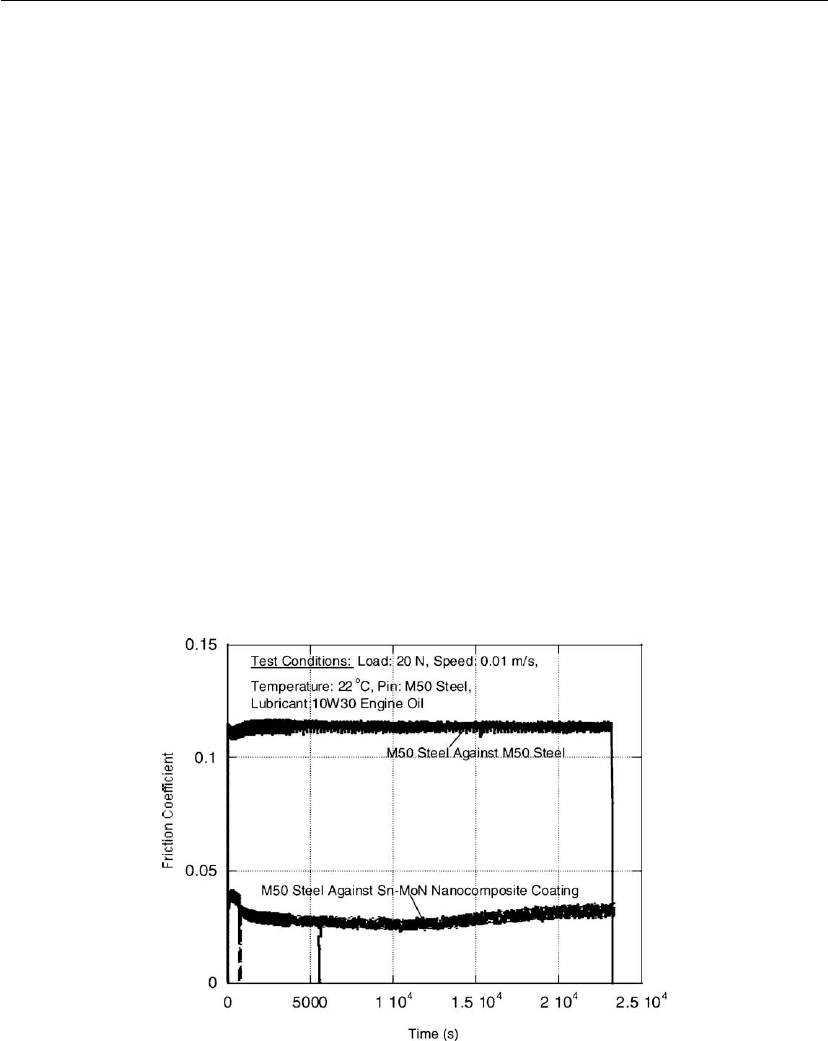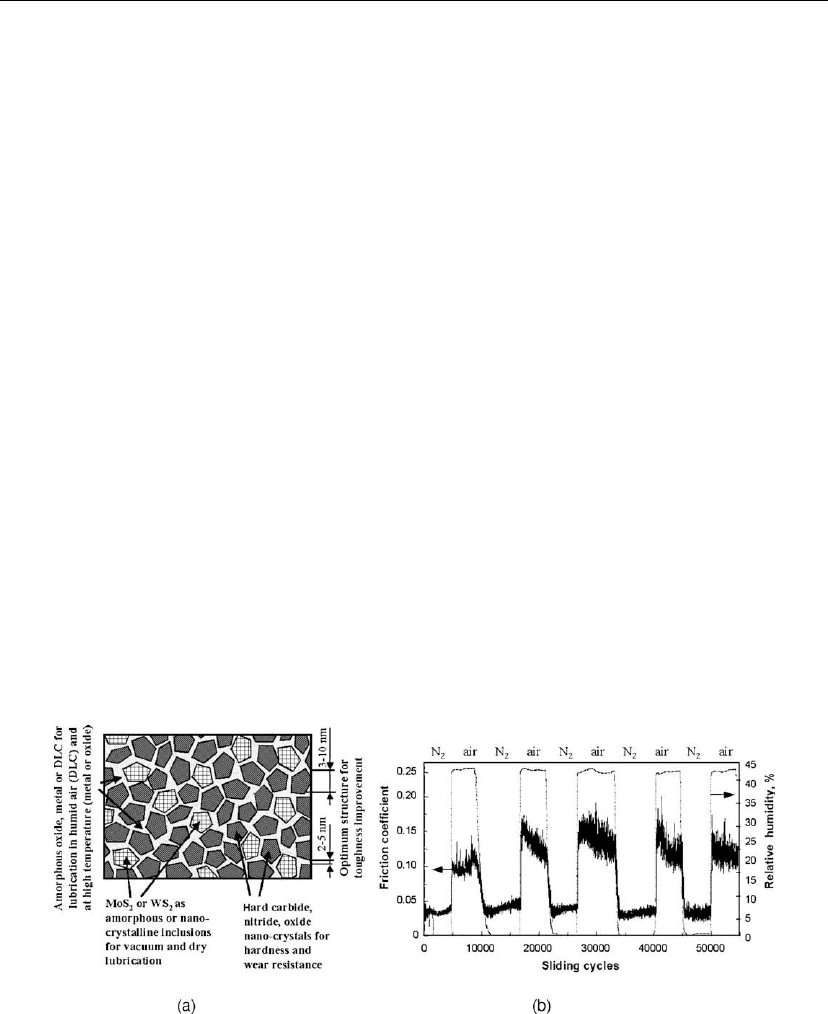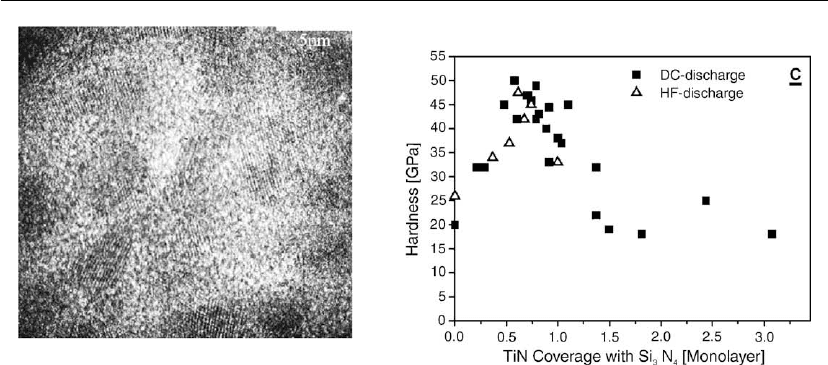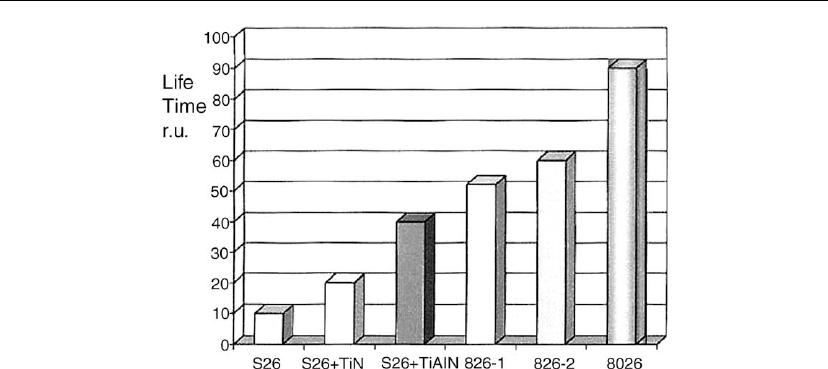Martin P.M. Handbook of Deposition Technologies for Films and Coatings, Third Edition: Science, Applications and Technology
Подождите немного. Документ загружается.


Nanocomposite Coatings for Severe Applications 691
Table 14.1: Examples of superhard coatings and their grain size and mechanical properties
Coating Average grain
size (nm)
% Cu (at.) Hardness,
H (GPa)
E*(E/(1 − v
2
))
(GPa)
Refs
Zr–Cu–N 38 1–2 55 395 [59–61]
Zr–Ni–N 6 4.1 (Ni) 57 430 [62]
CrCu–N 70–90 1 35 [63]
Al–Cu–N 9, 5 8, 1 47 313 [61]
Zr–Cu–N 10–15 23 23 250 [59–61]
ZrN – 0 16 [60]
nc-TiN/a-Si
3
N
4
40–60 > 500 [6, 64]
nc-TiN/a-Si
4
N
4
/a-TiSi
2
> 80 [30]
Considering both models, with the selection of the right kinds of grain and grain-boundary
phases, one can produce hard and tough nanocomposite coatings. For example, if the grain
boundaries in a coating are made of a strong phase, then the dislocation motion will become
very restricted, or the dislocations will be effectively confined to the grains themselves; hence,
the coating will endure high loads before there is a major deformation or fracture. Using such
an approach, many research groups have recently developed nanocomposite coatings and
demonstrated their superhard nature. Table 14.1 presents some of these coatings and their
compositions. Those coatings with hardness values of 40 GPa or more are considered
superhard. Their grains are in nano domains (3–5 nm), and the grain boundaries are decorated
by very thin (one atomic layer) and immiscible grain-boundary phases [7]. Again, the selection
of the phases that make up the grain boundaries is important. The phases must be immiscible
yet strongly bonded at the grain boundaries so that they do not easily yield to dislocation
motions from one grain to the next.
The mechanical hardness of nanocomposite coatings is among the highest, and many of them
are designated as superhard. A simple rule of mixtures cannot be used to estimate their
hardness. Typical hardness values for nanocomposite coatings vary between 40 and over
90 GPa. For example, TiN/Si
3
N
4
, Ni/ZrN, and Cu/MoN exhibit hardness values greater than
40 GPa [4, 5, 7, 29, 53]. If a rule of mixture had been used to estimate their hardness, their
composite hardness values should have been much lower. In reality, they exhibit hardness
values two to three times higher than the phases they are composed of. At higher
concentrations or volumes of metallic phases (over 50%), nanocomposite coatings may exhibit
hardness values less than 10 GPa, while at very low concentrations (1–4%), the hardness goes
up, and values greater than 50 GPa are feasible. In short, the hardness of nanocomposite
coatings can be tuned by varying the concentration of individual phases that make up the bulk
coating. It is important to note that the hardness of all coatings may be influenced by the levels

692 Chapter 14
of internal stresses within these coatings. Therefore, one has to determine the extent of internal
stresses in relation to the hardness of a given coating. A high level of internal stress may be
beneficial to the hardness of a coating, but it is also detrimental to the fatigue and wear
resistance of such coatings.
Another impressive property that makes nanocomposite coatings unique is their superior
fracture toughness, which is important for durability of hard coatings in most mechanical
applications where cyclic shear and normal forces are applied [65]. Hardness is important for
load-bearing capacity of a coating, but fracture toughness is equally important for resisting
crack initiation and growth. Recent experimental studies have confirmed that most
nanostructured and composite coatings possess relatively high fracture toughness [53, 66]. The
high fracture toughness of nanocomposite coatings has been attributed largely to their
nano-sized grain morphology. Specifically, nano-sized grains with a large-grain boundary
network are believed to provide an ideal condition for resisting crack initiation in superhard
coatings [55]. Even if a crack initiates within a grain, strong and thin (order of one monolayer)
grain boundaries can deflect and branch them, reducing the stress concentration factor and
arresting further crack growth. Grain-boundary sliding was also suggested as a mechanism for
crack energy dissipation at highly localized strains in nanocomposite tribological coatings
[14]. Overall, compared to most traditional hard coatings, nanocomposite coatings are ideal
for demanding mechanical applications, such as high-speed cutting tools or load-bearing
aerospace materials.
While high hardness and toughness are critical for the proper functioning of a coating in
intended applications, for such coatings to last long, they must also have strong adhesion or
bonding to the substrate materials. In most tribological applications, adhesion determines a
film’s endurance life, load-bearing capacity, and effectiveness in such applications. In fact,
strong adhesion between a coating and its substrate is perhaps the most important prerequisite
for most mechanical and tribological applications [67, 68]. Even if the coating is superhard
and tough, with poor adhesion, it fails quickly under the influence of high normal and shear
forces in most mechanical applications. As mentioned earlier, high levels of internal stresses
may cause adhesive as well as cohesive delamination in a coating. The effect of internal
stresses is the greatest at the film–substrate interface. If the adhesion of the coating to the
substrate is poor, then the coating delaminates from the surface. High levels of physical
intermixing and chemical reactions between the constituents of coating and substrate materials
can significantly improve the adhesion of coatings. Also, poor mechanical interlocking at the
coating–substrate interface may increase the likelihood for delamination.
With the use of modern deposition processes, achieving strong bonding between hard coatings
and their substrates is easy. Most of the advanced techniques such as arc-PVD and HIPIMS are
able to promote high levels of interdiffusion or mixing between coating and substrate atoms at
the interface and thus very strong bonding.

Nanocomposite Coatings for Severe Applications 693
14.4 Nanostructured and Composite Coatings
for Tribological Applications
During the 1980s, transition metal carbides, nitrides, borides, and oxides attracted the greatest
attention for tribological applications. However, during the last decade or so, attention has
shifted to multifunctional nanocomposite coatings with gradient, duplex, multilayered, and
nanocomposite architectures, mainly because of their superior tribological properties and
diverse application possibilities in transportation, aerospace, and manufacturing fields [8, 15,
32]. Owing to their nanocomposite nature, these coatings can provide high fracture toughness
in addition to high mechanical hardness and resilience under severe loading conditions for
many tribological applications. If the phases are selected strategically, they can achieve
self-lubricating capacity and provide low-friction and low-wear coefficients over a broad range
of test conditions, temperatures, and environments. Some of the nanocomposite coatings may
also enable machining or manufacturing under dry or marginally lubricated conditions [5, 7].
This is a much desired goal in many engineering applications but not easy to realize. In such
coating architectures, the ingredients of each layer are strategically selected so that they may
become lubricious through tribochemical interactions with the chemical species in operating
environments under the influence of ambient or frictional heating, thus enabling tools to
operate even in the absence of additional liquid or other lubricants [69].
In most tribological applications, nanostructured and composite coatings are expected to
provide superior friction and wear. Some of the other important requirements are strong
adhesion to the substrate material, high mechanical hardness and toughness, high
thermal/chemical stability, uniform and adequate thickness, dense morphology, smooth
surface finish, and self-lubrication. Recent experimental work which was referenced in the
above paragraph has shown that when all of these requirements are met, the tribological
coatings can improve the performance and durability of tools and components. For example, in
metal-forming and metal-cutting operations, where the wear mechanism is dominated by
microfracture or plastic deformation, nanostructured and composite coatings can resist crack
initiation because of their high fracture toughness. Because of their hardness, under heavy
loading in vertical directions, they can resist deformation on the surface as well and thus
increase the load-bearing capacity of base materials.
Besides the manufacturing and machining applications, nanocomposite coatings are attractive
for use in transportation, biomedical, and aerospace fields [70, 71]. In the field of
transportation, the use of liquid or grease lubricants (engine oils, greases, etc.) with all kinds of
chemical additives is essential for the functionality and durability of most sliding, rolling, or
rotating components. One of the key additives is zinc dialkyl dithiophosphate (ZDDP), which
is used in almost all types of engine and other industrial lubricants owing to its ability to
withstand extreme pressures and its anti-friction, anti-wear, and anti-oxidation characteristics,

694 Chapter 14
especially under severe contact conditions. Without it, most current lubricants become
essentially useless. Another important additive is molybdenum dialkyl dithiocarbamate
(MoDTC), which is used primarily to control friction between sliding surfaces. Both of these
key anti-friction and anti-wear additives were recently found to be environmentally unsafe
and/or potential carcinogens. In particular, ZDDP has been determined to adversely impact the
emission control and after-treatment devices of modern engines by poisoning their catalyst
systems (especially the NO
x
catalyst in diesels). Both ZDDP and MoDTC contain heavy
elements besides sulfur and phosphorus, and hence, they contribute to the particulate
emissions. Furthermore, the sulfur in these additives reacts with moisture in the combustion
chamber and forms acids, which can trigger corrosion and additional wear problems on sliding
surfaces.
At the moment, the uses of these lubricants in transportation and other industrial sectors are
being curtailed mainly because of their harmful effects on the environment. The most desirable
scenario will be to engineer both the coatings and future lubricants in such a way that they
become compatible or complementary to one another’s performance characteristics, and as a
whole, they represent a better lubrication possibility than what can be provided by either of
them. For example, in a specially designed nanocomposite coating, while one phase provides
extreme resistance to wear and deformation, a second or third phase may preferentially react
with the additives in oils to provide high lubricity and protection against wear. It is also
possible to design new nanocomposite coatings around the existing liquid lubricants or
additives to achieve further improvements in lubrication performance [8, 72]. These coatings
can be regarded as smart or adaptive tribological coatings because of their excellent
compatibility with, and favorable response to, the lubricants and test environments.
In addition to the lubricated contacts, nanostructured and composite coatings can be useful in
other tribological applications involving dry sliding at elevated temperatures or high vacuum
and corrosive environments. Despite being chemically stable, under very aggressive or
oxidative conditions, these coatings may undergo minor oxidation. In most tribological
applications, in addition to the temperature of the operating environment, significant frictional
heating may also exist and trigger chemical and/or oxidative interactions with the solid, liquid,
or gaseous media in the test environments. Some of the reaction products are self-lubricating,
while others might be hard and abrasive; hence, they are detrimental to the lifetime of the
coated component. At present, high-speed machining or sliding is greatly desired in numerous
industrial applications, which call for much higher chemical and thermal stability for the
nanocomposite coatings. In addition to the traditional oxidation-retarding elements, such as
Cr, Ti, and Al, more exotic elements like Y and Ce are being incorporated in many composite
coatings to further enhance their resistance to oxidation [73]. Some of the tools and dies used
in many manufacturing operations are routinely coated by such means to achieve superior
resistance to oxidation as well as wear and scuffing.

Nanocomposite Coatings for Severe Applications 695
Conventional PVD coatings can be anisotropic, and most are made of a columnar
microstructure. Under heavy loading, deformation or fracture can occur through the column
boundaries. However, in the case of nanostructured and composite coatings, the grains are
extremely small, and the morphology is not necessarily columnar; hence, they cannot be easily
deformed or fractured under loading. The average grain size of nanocomposite film is in a
range that is not well suited for crack initiation and propagation. In another words, Griffith’s
criteria for crack growth are difficult to meet in nanostructured and composite coatings [74].
Therefore, one of the main reasons why nanostructured coatings exhibit superior wear
properties is that they are better able to prevent crack initiation and growth.
Another unique feature of the nanostructured and composite coatings is that, mainly because
of their superhardness and stiffness, the real contact areas are very small during a tribological
sliding situation. When combined with high chemical inertness or stability, smaller contact
areas on a sliding surface may often lead to lower friction (especially if one of the constituent
phases is self-lubricating). For most tribological applications, low friction in addition to low
wear and high resistance to galling or scuffing are major requirements. Nanocomposite
coatings can be designed to include a self-lubricating phase, such as MoS
2
, to provide low
friction, while the hard phase can provide low wear. In lubricated sliding applications, one of
the phases may be selected from those metals that can easily form self-lubricating secondary
films on the sliding surfaces and thus provide much lower friction. Figure 14.5 shows the
frictional behavior of a nanocomposite MoN–Sn film under boundary-lubricated sliding
Figure 14.5: Friction coefficients of steel sliding against steel and steel sliding against Sn–MoN
nanocomposite film under boundary-lubricated sliding conditions [72] (Courtesy of CRC
Publications).

696 Chapter 14
conditions. When compared with an uncoated steel surface, the Sn–MoN coating provided a
much lower friction coefficient. It is possible that such a reduction in friction is due to the
low-shear-strength Sn phase in the nanocomposite structure. Tin may have also reacted with
additives in oil to produce a low-shear boundary film on the sliding surface.
During the last two decades the cost of PVD and CVD coatings has decreased significantly. As
a result, these coatings are now used for a wide range of mainstream applications. In particular,
in the field of machining and transportation, vacuum-based hard coatings are replacing or
supplementing the traditional surface treatments, such as carburizing and nitriding. Obviously,
different applications require different coatings with different thickness, hardness, and
chemical composition. For example, the requirements for coatings in cutting and forming
operations are different from those in engine applications. High-temperature oxidation
stability, adhesion, thermal conductivity, affinity of the coating material for the counterface
material, and hardness are the most important factors in cutting and forming operations;
surface roughness, fatigue resistance, better cohesion and adhesion, wear resistance, low
frictional behavior, and responsiveness to additives in engine oils are the most important
requirements from coatings in transportation applications. In addition, some other issues need
close attention. For cutting and forming tools, highly alloyed and expensive steel substrates
(such as high speed steel and M2 tool steel) are often used, and they can endure deposition
temperatures of up to 450–500
◦
C without significantly compromising their high hardness;
however, low alloyed and cheap steel substrates are more common in engine components
because they keep the cost down, and usually maximum deposition temperatures cannot
exceed 150–200
◦
C.
The remainder of this section individually treats the different types of coatings developed for
tribological applications.
14.4.1 Self-Lubricating Nanocomposite Coatings
For many years, researchers and practitioners have prepared and used many types of
composite materials to combat friction and wear in mechanical applications [75, 76].At
present, several kinds of metal-, ceramic-, and polymer-matrix composites are impregnated
with graphite, molybdenum disulfide, polytetrafluoroethylene (PTFE), and hexagonal boron
nitride, which can provide low friction in sliding bearing applications. These and a few other
composite materials, which are available as fairly thick (0.1–0.2 mm) coatings, are used for
combating friction and wear, especially at elevated temperatures [77].
Most self-lubricating composite materials can also be applied on a surface by plasma spraying
or electroplating methods [78]. Electroless nickel, chromium, and nickel–phosphorus coatings
that contain small amounts of nanoscale graphite, MoS
2
, PTFE, and diamond particles can be
produced and used to achieve relatively thick metal-matrix films with self-lubricating

Nanocomposite Coatings for Severe Applications 697
properties [79]. In addition to these traditional practices, the modern PVD methods mentioned
above can be used to deposit self-lubricating materials as thin (a few micrometers)
nanocomposite coatings. Conceptually, the approach is similar to the conventional methods
used in the production of the bulk self-lubricating composite materials and/or coatings
mentioned above. However, structurally, the individual grains that make up such coatings are
on the nanoscale or mixed homogeneously within the produced layers. For example, self-
lubricating MoS
2
films have been used extensively by the aerospace industry to achieve and
maintain low friction for many years. However, as a monolithic film, MoS
2
may not provide
very long wear life. Extensive research into alloying MoS
2
and WS
2
with certain elements or
compounds, such as Ni, Pb, Ag, Au, C, Ti, Sb
2
O
3,
TiN, and PbO, resulted in much improved
wear life and reduced environmental sensitivity [80–83]. During deposition of alloyed MoS
2
or WS
2
films, deposition temperatures and other parameters can be controlled to achieve dense
structure or morphology, and the texture or orientation of the films can be manipulated to
achieve additional life extension and superior frictional behavior. Under certain deposition
conditions, the nanocomposite or alloyed films become amorphous, but during tribological
testing, they revert to a crystalline structure, which is essential for low friction [80, 84].
As in bulk self-lubricating composite materials, the soft solid lubricant phases in
self-lubricating nanocomposite films are often selected from graphite, hexagonal boron nitride,
and transition metal dichalcogenides such as molybdenum, tungsten, and niobium disulfide or
diselenide. Their self-lubricating characteristic is related to a layered crystal structure.
Specifically, the crystal structures of these solids are made of atomic layers in a stack. The
atoms lying in the same layer are closely packed and strongly bonded to each other, while the
layers are relatively far apart, and they are held together by weak van der Waals’ forces. When
present between sliding surfaces, these layers can align themselves parallel to the direction of
relative motion and slide over one another with relative ease to provide low friction. Among
the many types of nanocomposite coatings, the ones that contain WS
2
and MoS
2
have become
very popular owing to their very low friction and wear coefficients. They are well-suited for
many types of aerospace applications [71, 83]. Typical friction coefficients available through
the use of such nanocomposite coatings are in the range of 0.01–0.05 in vacuum or inert test
environments.
With the addition of certain metals (like Ti, Cr, and Ni), relatively hard versions of MoS
2
and
other films have been produced, and as a result much longer wear life has been achieved in
these coatings. The friction coefficients of such coatings were also shown to be much lower in
humid air compared to those of the monolithic MoS
2
films. For example, the friction
coefficient of a MoS
2
–Ti film against steel or ceramic balls is below 0.1 in humid air and less
than 0.05 in dry N
2
; when compared with conventional MoS
2
films, its Vickers hardness is
much higher and hence it lasts longer in tribological applications [85]. Furthermore, the
frictional properties of this coating are not greatly affected by moisture in the test environment,
and it is proposed for use in various dry-sliding and machining applications (e.g. milling,

698 Chapter 14
drilling, tapping, cold-forming dies and punches, stamping, bearings, and gears for aerospace
and vacuum applications) [85, 86].
Various research groups have attempted to co-sputter MoS
2
with hard nitrides, borides, and
oxides to achieve much longer durability in sliding bearing applications. As an example, this
method can be used with either TiN or TiB
2
targets or a single target that consists of both TiN
and MoS
2
. As a result, the coatings are made of distinct nanolayers or phases of hard ceramic
and soft MoS
2
phases. Depending on the amount of the hard phase, the hardness of the
composite coating can be as high as 20 GPa, while their friction coefficients are in the range of
0.1–0.3, even in humid environments. These coatings can also perform well in machining [87].
When softer metallic or ceramic phases are used, the resultant nanocomposite films are also
soft. For example, sputter deposition of multiple layers of MoS
2
and Pb results in a relatively
soft film, but the wear life is much longer than that of either the MoS
2
or Pb films [88].
Using sputtering, pulsed laser, or arc-PVD methods, more complex multicomponent
TiC/DLC, MoS
2
/TiC/DLC, or WS
2
/WC/DLC coatings have also been introduced, and as a
result much improved tribological properties have been achieved over broad ranges of
temperature and environmental humidity [15, 89]. These are also called adaptive or chameleon
coatings owing to their reversible tribological properties, permitting stable operation and
endurance in the cycled humidity and space-ambient environments needed for aerospace
applications. Figure 14.6(a) shows a schematic of such a coating architecture, while Figure
14.6(b) shows how an actual nanocomposite coating produced according to such architecture
behaves during testing in humid and dry environments [15]. The hard TiC and DLC phases in
these coatings provide high strength and resistance to wear, while the solid lubricants DLC and
MoS
2
ensure low friction in humid and dry environments, respectively.
Figure 14.6: (a) Schematic illustration of a nanocomposite coating with chameleon-like surf ace
adaptive behavior and (b) frictional behavior; a YSZ/Au/MoS
2
/DLC coating during a test with dry
nitrogen and humid air environments. Note that frictional response is reversible and dominated
by lubrication provided by MoS
2
in dry nitrogen and by DLC in humid air [15].

Nanocomposite Coatings for Severe Applications 699
Figure 14.7: (a) High-resolution TEM image of TiN/Si
3
N
4
nanocomposite coating, and
(b) dependence of hardness on the thickness of the grain-boundary Si
3
N
4
phase [90].
14.4.2 Superhard Nanocomposite Films
Nanocomposite coatings are made of either alternating layers of two or more chemically
distinct phases or one of the phases dispersed or embedded into another phase. In the case of
layered nanocomposite coatings, layers can be made of metallic and/or ceramic-based
materials, and the thickness of each layer can be controlled down to 1 nm or less or up to
several tens of nanometers. Mixed nanocomposite coatings can have a minor and a major
phase; often, the minor phase is in the crystalline form while the matrix or major phase is
crystalline or amorphous. Figure 14.7 shows a high-resolution TEM image of the TiN/Si
3
N
4
system, together with its hardness profile with respect to the thickness of the grain-boundary
Si
3
N
4
phase [90]. The TiN/Si
x
N
y
system is one of the most studied, mainly because of its
reported superhardness. While TiN represents the major or crystalline phase, Si
x
N
y
makes up
the grain-boundary phase and is reported to be amorphous. The other major phases that have
been used in the synthesis of similar superhard coatings include VN, NbN, ZrN, and (TiAl)N,
again, embedded in an amorphous Si
3
N
4
matrix [7, 30, 74, 91, 92].
Owing to their superhardness, these coatings are resistant to wear, abrasion, and erosion. Their
thermal stability has also been reported to be excellent; hence, they are well suited for
high-speed machining or high-temperature metal-forming operations. Their sliding friction
coefficients are not very low under dry-sliding conditions. A liquid and/or solid lubricant must
be used to achieve reasonably low friction coefficients in sliding contacts. The superhardness
and high thermal stability of these coatings are thought to be the main reasons for their
protection against wear. Under lubricated sliding conditions, they can also provide low
friction, which is important for saving energy in many sliding contacts. Besides the system

700 Chapter 14
Figure 14.8: Cutting performance of various hard coatings while milling a CK45 steel. (Cutting
conditions: feed rate, 0.23 mm/tooth; depth of cut, 2 mm; cutting speed, 179 m/minute). S26:
indexable uncoated insert; S26 + TiN: TiN-coated; S26 + TiAlN: (TiAl)N-coated; 826-1 and -2:
same inserts coated with (Ti
1−x
Al
x
)N/a-Si
3
N
4
nanocomposite coatings; 8026:
nc-(Ti
1−x
Al
x
)N/a-Si
3
N
4
multilayer nanocomposite coating [91] (Courtesy of Pure and Applied
Chemistry).
mentioned, numerous other multilayer superhard coatings have been developed in recent years
and studied extensively under various machining and sliding conditions. For example, a series
of composite systems consisting of CrN/NbN and TiAlN/VN has been developed and studied
extensively for their friction- and wear-reducing abilities [29, 73, 93].
The nanocomposite coatings mentioned above have been fully developed and offered for
industrial uses in recent years. Compared to their single-component predecessors, such as TiN,
TiC and (TiAl)N, they work extremely well. For example, in a series of machining trials,
nanocomposite TiN/Si
3
N
4
coatings exhibited significantly higher durability, as shown in
Figure 14.8 [91]. As can be imagined, during such cutting operations, the cutting edges of
tools become very hot. Therefore, the nanocomposite coatings must have the ability to resist
oxidation and maintain their superhardness and structural integrity; otherwise, they lose their
nanocomposite natures and then their superhardness, which is essential for their impressive
performance in such severe applications [94].
14.4.3 High-Temperature Adaptive Nanocomposite Coatings
High-temperature friction and wear reduction in oxidizing environments is one of the most
difficult challenges for which nanocomposite coating architectures provide a considerable
breakthrough, offering surface adaptation capability in various temperature regimes, resisting
oxidation, and sustaining high contact loads. Oxides are most typically used. Many oxides
